Any material - brick, wood, plastic - needs to be repaired and updated over time. Painting a wooden house inside is one simple and effective way to redesign, protect walls and floors, and restore functionality.
The need to paint a wooden house inside
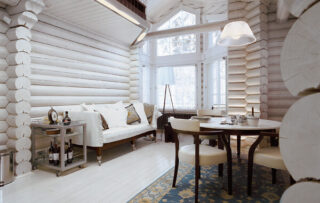
Wood is a porous material. This feature is both an advantage and a disadvantage. Wood absorbs excess moisture from the indoor air and removes it outside, so it is never stuffy or humid in a log house. However, with high humidity, the tree is no longer able to remove it. Then the walls and floor in the building are deformed, moldy, rot.
Painting the timber inside and outside the house protects the material. The paint forms a thin waterproof film on the surface. In this case, moisture no longer gets inside the tree. This is not the only advantage of painting:
- Paint is an extremely versatile finishing material. They produce shiny and matte compositions, transparent and with a high level of hiding power, textured and smooth. The richness of shades is enormous.
- Painting takes a minimum of time, this is one of the fastest finishing methods.
- Dyeing is a simple job. Even a beginner can completely change the design of a room with paints and varnishes.
- Compositions with high density and texture hide small irregularities and defects.
- Interior log paint protects wood from more than just moisture. The composition prevents the development of fungi, mold infection, since most of them have an antiseptic effect.
- The polymer layer protects the tree from bark beetles and other harmful insects.
- Paints, even the most expensive ones, cost much less than finishing with clapboard or plaster.
When choosing a coloring composition, the purpose of a particular room is taken into account. For bathrooms and kitchens, smooth surfaces are preferable, as they do not accumulate dirt and are easier to maintain.
Paint selection rules
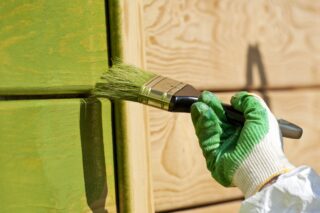
Paint for wooden walls inside the house should be not only practical and beautiful, but also safe. Indoors, it is allowed to use compounds that, during drying and further operation, do not emit harmful substances, strong odors, etc.
For interior decoration, water-based and organic paints are used. The former are not always resistant to water. Some of them can be washed off with water. Organic solvent formulations generally have higher hiding power, water resistance and durability. However, you need to choose them with caution: not all solvents are safe for humans and pets.
Oil
A variety of organic-based coatings - drying oil. The thinner is white alcohol, turpentine, gasoline. The cost is low, the hiding power is high: the wood grain becomes invisible. Oil paints fit well, because of the large thickness of the layer, they mask minor surface defects. Such a coating is not afraid of moisture, it can be washed with plain and soapy water.
Among the disadvantages, it is worth mentioning the long drying time and the pungent smell due to the solvent.During drying, the composition emits harmful substances, therefore, it is impossible to enter the painted room for several days.
Oil paints are more often used for exterior decoration. However, they are often used for painting kitchens and bathrooms, where high resistance to water is important.
Acrylic
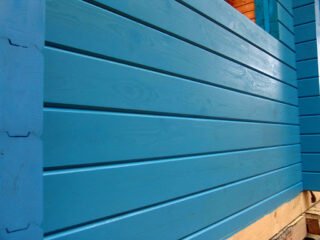
A kind of water-based dispersion paint. The solvent is ordinary water, which makes the composition safe. The coloring matter - polyacrylates, is introduced into the mixture in the form of a dispersion, not an emulsion. This feature provides a higher resistance to water in comparison with water emulsion: the acrylic coating does not wash off the walls and withstands repeated wet cleaning.
Acrylic paints can be diluted with water to make the shade less intense, and added to the solution with aqueous pigment pastes to obtain a different color. This increases the color gamut noticeably.
Acrylic paint darkens as it dries.
Alkyd and enamels
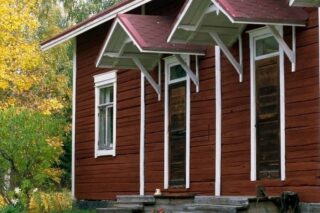
Paints and enamels of this kind are based on alkyd resin. When dry, the substance forms a very dense, smooth, even surface, so that most of the enamels are glossy or shiny. The paint completely hides the pattern and color of the wood. They use enamels for interior and exterior decoration, since the finished coating is absolutely not afraid of water and aggressive household chemicals.
The composition is very durable, dries quickly. However, the solvent for it has a strong unpleasant odor, which does not disappear until it dries completely. Although not all formulations release toxins, work should only be done with a respirator.
When choosing, you need to pay attention to the composition of the paint and the purpose. Not all options are suitable for painting wooden or log walls inside your home.
Water-dispersive
The base of the composition is water. Coloring pigments and fillers are in the form of dispersions. A common feature of such paints is resistance to water and steam.
Water-dispersive ones include polyvinyl acetate, latex and acrylic. The former are used only indoors with low humidity, as they are unstable to the action of water. The latex compound can be used in the bathroom and in the pool, so it tolerates the influence of steam. Acrylic paint is an option for wood inside and outside the house.
Silicone
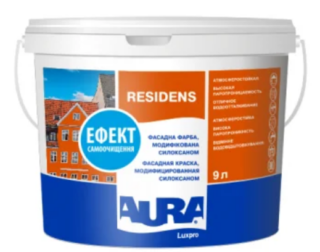
For painting a wooden house inside, a silicone resin-based mixture seems to be one of the best options. With high water resistance, the coating is air permeable, which retains all the advantages of a wooden building. The paint does not fade in the sun, is completely insensitive to mold and mildew, does not wear off.
Silicone compound is one of the most resilient coatings available. The finishing layer masks cracks up to 2 mm wide. The composition can be pigmented by changing the shade and intensity.
Silicone paints are only matte.
The choice of paint for the intended purpose
Living room paint is not always suitable for the kitchen. To figure out which option is right, you need to pay attention to the digital code in the marking. Its first numbers indicate the special properties of the paint:
- 1 - weatherproof;
- 2 - intended only for interior work;
- 3 - used for metal structures, not suitable for lining or timber;
- 4 - resistant to hot water and steam, it is chosen for the bathroom and kitchen;
- 5 - special, for example, for leather;
- 6 - resistant to oil products and fats, rarely used in everyday life;
- 7 - insensitive to aggressive environments;
- 8 - withstands high temperatures, suitable for the kitchen;
- 9 - has electrical insulating properties;
- 0 - these are primers and enamels;
- 00 - putties.
Steam or oil resistant formulations are more expensive than conventional formulations. So you should buy them only for finishing special rooms.
Required tools and materials
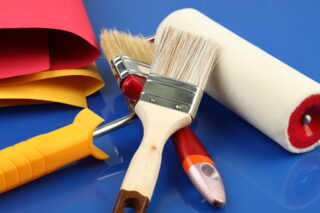
Before painting a log house or panels inside the house, you need to stock up on some tools and auxiliary materials:
- brushes and rollers, as well as trays for them;
- spray, if it is decided to paint the walls not by hand;
- masking tape - they cover surfaces that should not be painted;
- rubber gloves, protective clothing, in some cases a respirator or protective mask will be required;
- wet rag, sponge or bucket.
Films are also needed to protect floors, plumbing or furniture that cannot be taken out of the room.
Preparatory work
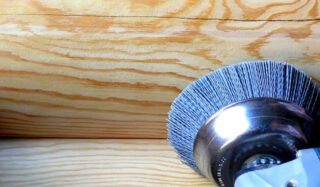
Painting a house inside begins with surface preparation. By its nature, a wooden wall remains porous. In order for the paint to lay flat on it, the following is required:
- The walls are cleaned of dust and dirt.
- Remove the old trim layer, if present. The paint is washed off or removed with a grinder.
- Examine the walls. If mold or rot spots are found on the tree, these places are cleaned with a metal brush. Then the sites are treated with antiseptic impregnations or primers to protect the tree from fungi and mold. Boards that have rotted more than half are replaced with new ones.
- The heads of nails and the remains of other fasteners are removed.
- Fallen knots, cracks, gaps are filled with plaster mixtures with sawdust. After drying, the areas are leveled with sandpaper.
- Before painting the wooden walls inside and outside the house, the surface is impregnated with a primer. This composition improves the adhesion of the paint to the wood.
Other measures may be needed, for example, leveling or sanding the walls, additional treatment with antiseptics or bleach.
DIY painting a wooden house inside
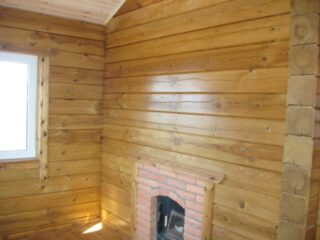
Algorithm of the main works:
- If the walls or floor are made of highly porous, soft wood, such as pine, the surfaces should be primed twice. The top layer of such wood absorbs the liquid composition, like a sponge. If you immediately paint a pine or apple tree with paint, the latter is absorbed and you have to apply an additional layer.
- After the primer has completely dried, the first coat of paint is applied. Brushes or rollers are used. To paint a large flat area, take a spray gun.
- Cover the wall with 2-3 coats of paint to achieve a good effect. Each next layer is applied when the previous one dries completely.
- If necessary, the painted walls can be additionally decorated. To add shine, cover the surface with a shiny varnish on top. To create the effect of antiquity, paints of several similar shades are used.
Painting wooden walls and floors is a quick and practical way to finish. The paint layer protects the material, prevents the appearance of mold or mildew and gives a new sound to the interior.








